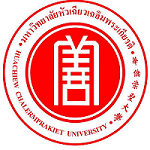กรุณาใช้ตัวระบุนี้เพื่ออ้างอิงหรือเชื่อมต่อรายการนี้:
https://has.hcu.ac.th/jspui/handle/123456789/4756| ชื่อเรื่อง: | สารัตถะของคําว่า “นโม” ในคัมภีร์พระพุทธศาสนาเถรวาท |
| ชื่อเรื่องอื่นๆ: | Essences of Namo in the Theravada Buddhist Scriptures |
| ผู้แต่ง/ผู้ร่วมงาน: | ธีรโชติ เกิดแก้ว Teerachoot Kerdkaew Huachiew Chalermprakiet University. Faculty of Liberal Arts |
| คำสำคัญ: | พุทธศาสนาเถรวาท Hinayana Buddhism Theravāda Buddhism การวิเคราะห์เนื้อหา Content analysis (Communication) พุทธศาสนา -- บทสวดมนต์ Buddhism -- Prayers and devotions |
| วันที่เผยแพร่: | 2024 |
| แหล่งอ้างอิง: | วารสาร มจร พุทธศาสตร์ปริทรรศน์ 8,2 (พฤษภาคม-สิงหาคม 2567) : 16-29. |
| บทคัดย่อ: | บทความวิจัย นี้มีวัตถุประสงค์เพื่อศึกษาการปรากฏและสาระสําคัญของคําว่า “นโม” ในคัมภีร์พระพุทธศาสนาเถรวาท ใช้ระเบียบวิธีวิจัยเอกสาร นําข้อมูลมาที่ได้มาวิเคราะห์เชิงเนื้อหาแล้วนําเสนอแบบพรรณนาวิเคราะห์ ผลการวิจัยพบว่า 1) คําว่า “นโม” ส่วนใหญ่ปรากฏในพระสุตตันตปิฎกพระวินัยปิฎกบางเล่ม อรรถกถาและฎีกา บางส่วนแต่ไม่ปรากฏในพระอภิธรรมปิฎก พบ 3 ลักษณะคือ นโมที่ใช้คําเดียว นโมที่ใช้ร่วมกับกริยาและการใช้คําอื่นแทน นโมเป็นคําสามัญที่ใช้แสดงความนอบน้อมต่อบุคคลและสิ่งเคารพทั่วไป ไม่ใช่คําศักดิ์สิทธิ์ที่มีอํานาจเชิงบันดาล และไม่ได้ระบุว่าใครเป็นผู้กล่าวคนแรก 2) สาระสําคัญของคําว่า “นโม” พบ 9 เรื่อง ได้แก่ (1) ความหมายโดยตรงคือความนอบน้อม และความหมายเชิงขยายความ คือ การสักการะ เคารพ บูชา ไหว้ กราบ และนมัสการ (2) บุคคลและสิ่งอื่นที่มีผู้แสดงความนอบน้อมพบทั้ง พระรัตนตรัย บุคคลทั่วไป เทวดา สัตว์ ปูชนียวัตถุปูชนียสถาน และธรรมชาติ (3) ธรรมเนียม การใช้นโมถ้าเป็นบุคคล อมนุษย์ สัตว์ และสิ่งเคารพทั่วไปจะใช้นโมคําเดียว นโมร่วมกับคํากริยา หรือคําอื่นแทน แต่ถ้าใช้กับพระพุทธเจ้า นอกจากจะใช้คําดังกล่าวแล้วยังใช้บทนมัสการ “นโม ตสฺส ภควโต อรหโต สมฺมาสมฺพุทฺธสฺส” 3 จบ (4) ลักษณะการใช้นโม พบ 2 ลักษณะคือ ใช้เป็น คําอุทานและแสดงความ นอบน้อม (5) อิริยาบถพบทั้งอิริยาบถยืน เดิน นั่ง นอน (6) แรงจูงใจ พบว่ามาจากความเลื่อมใส ความเชื่อ ความกลัว ความต้องการผลตอบแทน (7) วิธีปฏิบัติคือการห่มผ้าเฉวียงบ่า การคุกเข่า การทําอัญชลี วันทา อภิวาท และการกล่าวนโม (8) หลักธรรมที่สัมพันธ์กับนโม คือ อปจายนธรรมการบูชา คารวธรรม และกรรม (9) ผลของการแสดงความนอบน้อมพบทั้งระดับโลกิยะ เช่น ทําให้เกิดปีติปราโมทย์ และผลในระดับโลกุตตระ คือ เป็นปัจจัย ให้ บรรลุมรรค ผล นิพพาน The objective of this research article is to study the occurrence and significance of the term “Namo” in the Buddhist scriptures, using a documentary research method. The data was analyzed through content analysis and presented as a narrative analysis research report. The findings of the research are as follows: 1) The term “Namo” predominantly appears in the Suttanta Pitaka and some volumes of the Vinaya Pitaka of the Pali Canon, but it is not found in the Abhidhamma Pitaka. The patterns of occurrence of this term can be classified into three main types: standalone occurrences, occurrences in conjunction with verbs, and the use of alternative words with similar meanings. Importantly, “Namo” is considered a common term expressing general respect and reverence. It is not a sacred word with inspirational power and did not specify who spoke first. 2) The significance of term “Namo” is identified in nine aspects: (1) Direct expressions of reverence, including homage, respect, veneration, worship, obeisance. ( 2) Persons and other things that have been shown humility, including the Triple Gem, ordinary people, angels, animals, sacred objects, sacred places, and natures. ( 3) The custom of using Namo, if used a person, non-human being, animal, and things that are respected in general, only one word Namo is used. Namo combined with verbs or another word instead But if used with the Buddha In addition to using the above words, they also use a specific phprase “Namo Tassa Bhagavato Arahato Sammāsam buddhassa” is recited three ( 4) The expression of reverence through “Namo” is observed in two ways: as an exclamation of joy and as a formal expression of respect. ( 5) Physical Gestures of Reverence found in standing, walking, sitting, and lying down. ( 6) Motivations for Reverence found to come from faith, belief, fear, and a desire for rewards. ( 7) Practices associated with the expression of “Namo” include covering oneself with a cloth, bending the knees, performing prostration, observing specific days, practicing patience, and uttering the phrase “Namo”. (8) Moral principles related to reverence include the offering of virtuous deeds, worship, ethical conduct, and the karmic consequences. ( 9) The consequences of expressing reverence through "Namo" manifest on both a mundane level, leading to mental tranquility, happiness, steadfastness of mind, worldly and heavenly blessings, and on a transcendental level, resulting in the attainment of enlightenment, liberation, and the alleviation of suffering through adherence to Buddhist practices. |
| รายละเอียด: | สามารถเข้าถึงบทความฉบับเต็ม (Full Text) ได้ที่ : https://so06.tci-thaijo.org/index.php/jmb/article/view/274344/184725 |
| URI: | https://has.hcu.ac.th/jspui/handle/123456789/4756 |
| ปรากฏในกลุ่มข้อมูล: | Liberal Arts - Articles Journals |
แฟ้มในรายการข้อมูลนี้:
| แฟ้ม | รายละเอียด | ขนาด | รูปแบบ | |
|---|---|---|---|---|
| Essences-of-Namo-in-the-Theravada-Buddhist-Scriptures.pdf | 79.49 kB | Adobe PDF | ดู/เปิด |
รายการทั้งหมดในระบบคิดีได้รับการคุ้มครองลิขสิทธิ์ มีการสงวนสิทธิ์เว้นแต่ที่ระบุไว้เป็นอื่น
